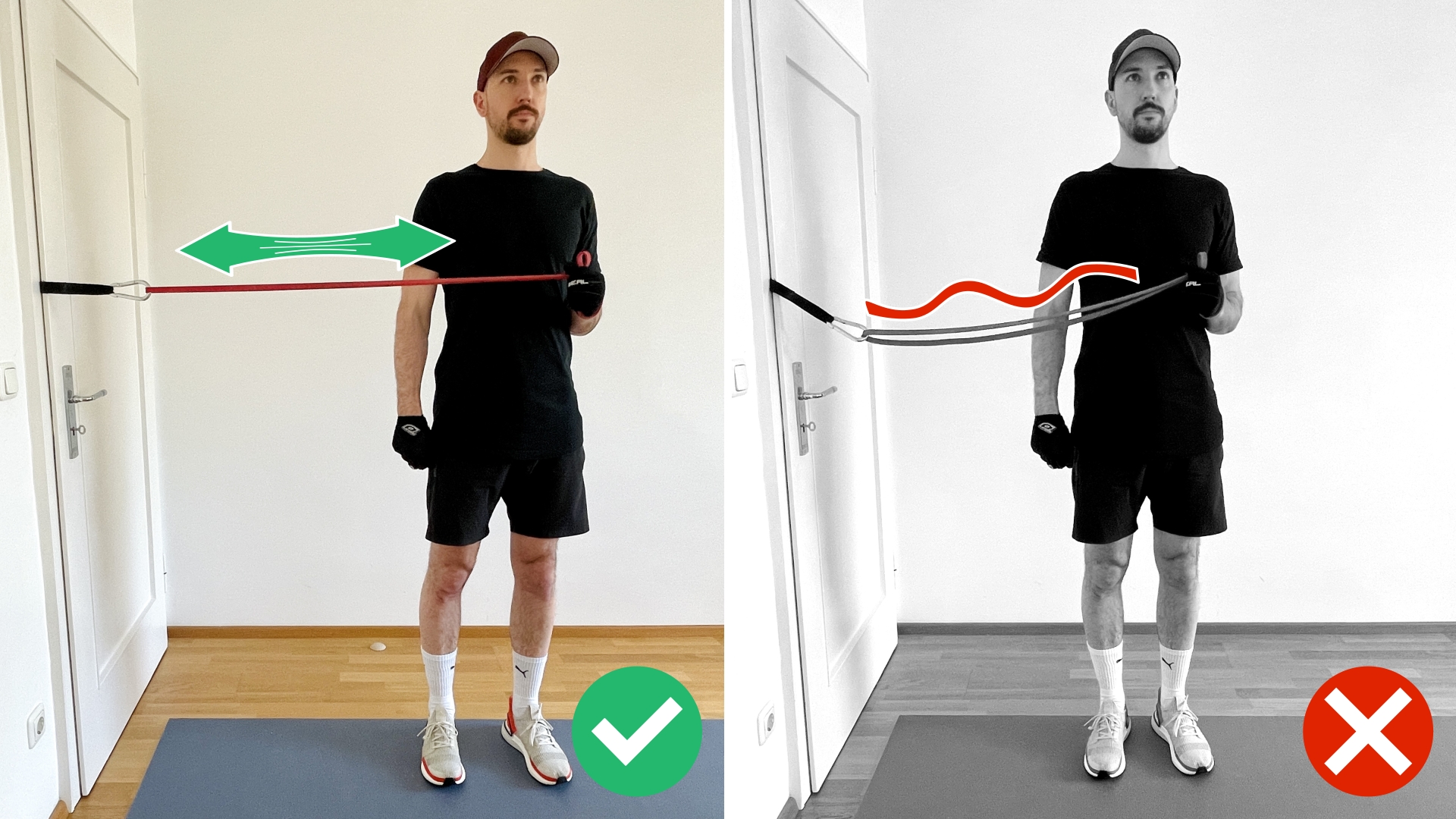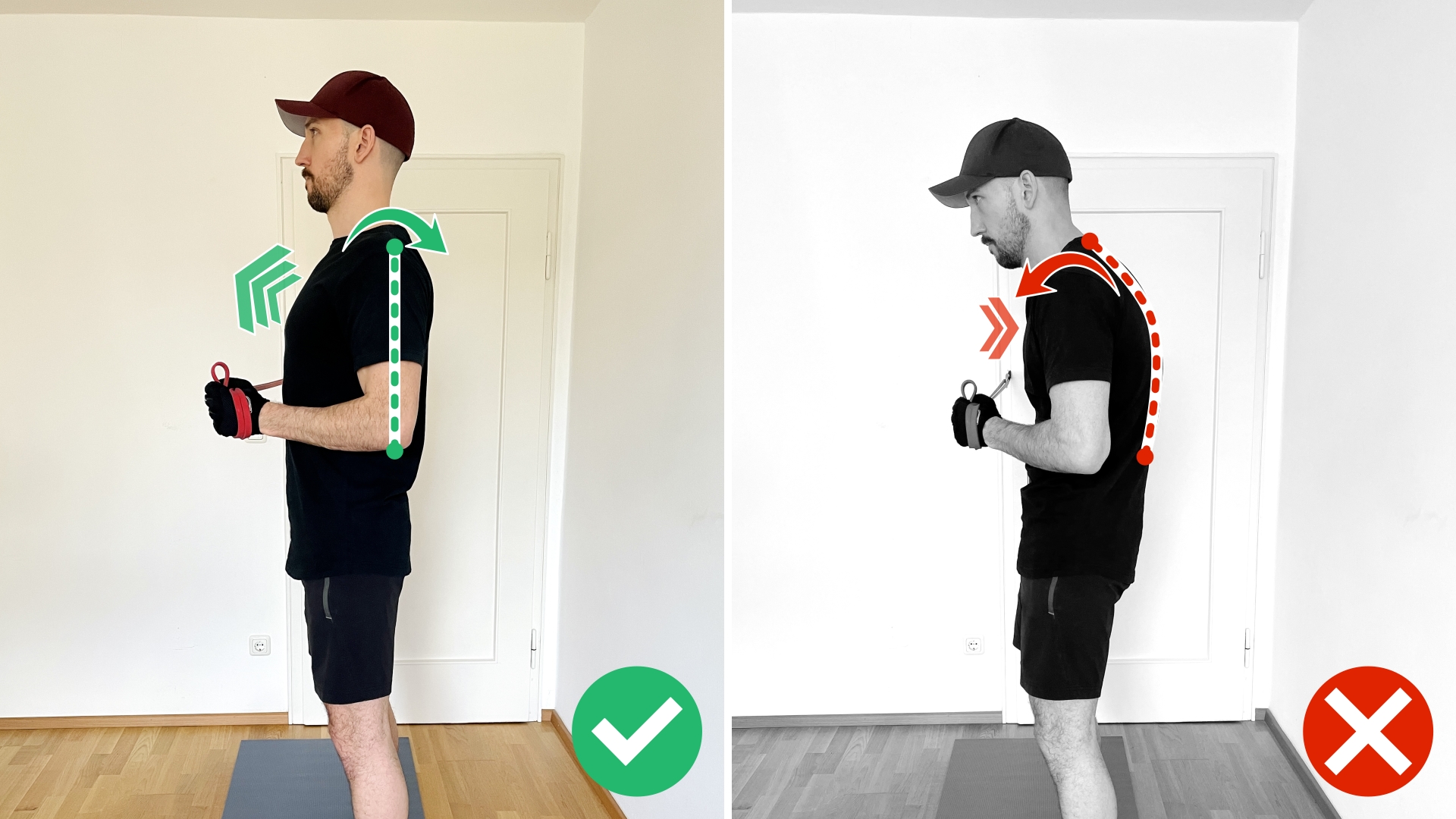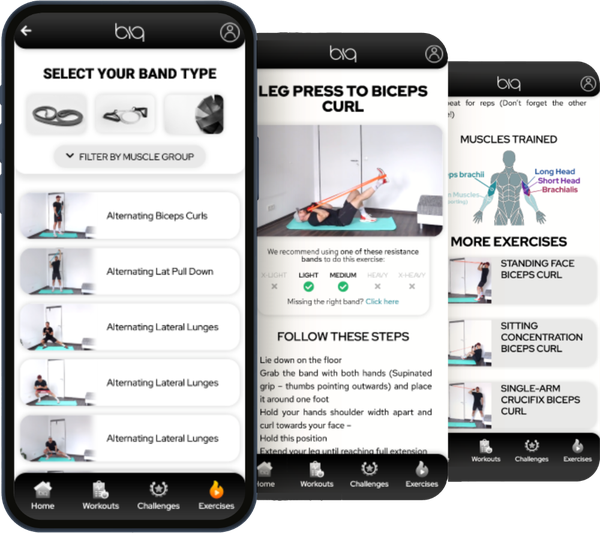Nowadays, some level of shoulder problems isn’t that uncommon. If it isn’t a result of a harder impact, it is often due to structural imbalances of the body. In case of the shoulder, it is often a stronger front in combination with a weaker back side. Especially the smaller rotator cuff muscles can be the cause of the problem. Since I implemented direct rotator cuff work into my training, the little annoying shoulder aches I had in the past, are a thing of the past. But even if you have strong and healthy shoulders at the moment, doing preventive exercise to strengthen the rotator cuff muscles is a fantastic idea.
Resistance bands are great to do external rotations, and they actually are my go-to tool for this exercise. They are easy to set up, and I feel the muscles contraction much more compared with a constant cable machine.
You will need a very light resistance band for this exercise. The muscles we are targeting are very small and a resistance which is too high will result in compromised exercise form where bigger muscles take over to move the load. A great way to always have the right band for the right exercise is by getting a set of bands with different resistance levels from the beginning. Don’t have a set yet? The one right here will be a good pick: Resistance Bands Set
In the following sections, you will get all the information you need regarding external rotations with resistance bands. We start by a detailed look at the basic variation, including steps and important Don’ts. The second part will be about ways to progress and variations to the basic version. And finally, we are going to finish it off with a quick look at the anatomy of the shoulder and ways to implement the exercises into a workout routine. Have fun!
How To Do External Shoulder Rotations The Right Way With Resistance Bands?
A little reminder before we dive into the how-to. Warming up before doing any resistance exercises is always a good idea and never a waste of time. This way you get your body prepared to move the load and decrease the chance of injury drastically.
You will need the following equipment to do the exercise. The most important is the resistance band, of course. Since you will need to anchor the band for this exercise, we highly recommend investing in a door anchor as the second piece of equipment. You can attach the band to other objects as well, but having and using a door anchor gives you flexibility and security in anchoring the band.
Using workout gloves is optional but highly recommended. This way, you will protect your hands against the friction generated when the band is stretched. In case you still don’t have any of those, have a look at these bad boys: Door Anchor and Workout Gloves
Next are the exercise steps which form the perfect external shoulder rotation with resistance bands. To get there, master the following 7 steps. Also check out the next section, where we will have a look at common form mistakes in this exercise.
- Attach the band to a door with a door anchor (height: around belly level)
- Grab the band with one hand and bend your arm 90 degrees, so your forearm is parallel to the floor
- Step away from the anchor point until there is tension on the resistance band
- Align your shoulders with the path of the band (Non-working side pointing towards the door anchor)
- Keep your arm bend and rotate your hand outwards
- Return slowly to the starting position (resist against the pull of the band)
- Repeat for reps (Don’t forget the other side!)
Form Mistakes To Avoid
⓵ No Tension = No-Go – if there is slack in the band in any position throughout the movement, it means that there is no tension in the band and therefore no resistance. Muscles are not active if there is no load. We don’t want that. Choose a distance from the anchor point which guarantees a stretch in the band throughout the whole range of motion of the external rotations.

⓶ Shoulders Back, Chest Up – letting the shoulders move forward, and the chest sink in is a big no-no. You want to be in a stable and strong position. Therefore, rotate your shoulders back and stick your chest out and up.

⓷ No Elbow Movement – really focus on having no movement in the elbow. This way you make sure to isolate the rotator cuff muscles and not getting the delts and back involved. Minimal movement is ok and sometimes unavoidable, especially if the lats are developed.
A little thing you can try is pressing something like a small towel or a pair of socks with the elbow against the side of your upper body. This way, you will consciously have to keep the elbow in one place to prevent the object from falling down.

If you are new to using resistance bands, we advise of having a look at this article: The Worst Mistakes You Can Do When Training With Resistance Bands
How To Progress
At some point, you will want to increase the intensity to make progress and challenge the muscles. When working out with weights, you would simply add weight. With resistance bands, there is a better way. In addition, increasing the resistance in this exercise is not the best approach in my opinion.
The best methods to adjust the intensity for external shoulder rotations are:
Slowing it down – The best way to advance in this exercise is by manipulating the exercise speed. We want to build stability in the rotator cuff. For that to happen, the small muscles have to be under a load for an extended amount of time. By performing the reps slower, you can keep the resistance very low (this makes keeping the exercise form clean much easier) and have a higher time under tension to get a stimulus for growth.
Adding a Pause – This is a variation of the previous method. Instead of doing the movement slower, you can add a pause or isometric hold in the contracted position. This will also result in a higher total time under tension.
Changing the Distance to Anchor point – one of the biggest advantages of bands is that you can change the resistance of a single band by changing the stretch. The more a band is stretched, the more pull it will generate, and therefore you will have more resistance to work against. This is great for shoulder rotations because you can only make very little jumps in resistance to make it more challenging, but keep the exercise clean at the same time. Take a small step further away from the anchor point, and you will have a more challenging set.
The best thing about this method is that you can adjust the resistance in the middle of a set by stepping further away or closer towards the anchor point.

Double String > Single String – with this setup, you can use only one string of a loop band to generate resistance. To achieve that, hold one string of the band with your free hand, so it can’t move. This way, you will have less resistance to work against.

The BIQ App
Take training with resistance bands to the next level with our free app.
- 800+ Exercises
- all band types
- different training goals & workouts
- challenges
- much more
Alternative Ways To Do External Shoulder Rotations With Resistance Bands
The version with the door anchor, which we discussed so far, is the best way to target the rotator cuff muscles consistently and effectively. But sometimes you just don’t have the space to use an anchored exercise or simply don’t have anything to anchor the band to. The two variations we show you in this section will be the solution in such circumstances.
2-Arm External Rotations (no door anchor) – to do this variation you will need a really light resistance band. If the resistance in this version is too high, you will definitely compromise the exercise form and involve the back instead of the rotator cuff muscles. Important is that there is tension in the band in the starting position (hands pointing forward).
Scarecrows (upward external rotation) – This version will work more on the upper muscles of your rotator cuff and is a great addition to the regular external rotation to the side.
How to do it:
- Get into a kneeling position and lock the band underneath your lower legs
- Grab the band with both hands
- Bend your arms 90 degrees and bring your elbows up, so your arms are parallel to the floor
- Keep your arms bend and rotate upwards until your hands point straight up
- Return slowly to the starting position (resist against the pull of the band)
- Repeat for reps
What Muscles Are Used In A Resistance Band External Shoulder Rotation
The shoulder joint is the joint with the most freedom of movement in the entire human body. With this freedom also comes a higher chance of something going wrong and being injured. This where the rotator cuff muscles come into play. Their job is to hold the joint together and together in a way that movements don’t do any damage to the joint.
Basically, they are the foundation of any bigger compound movements you do for your upper body, be it chest and shoulder pressing or rows and pull downs. The two main players of the rotator cuff muscles which make the external rotations of the shoulder possible are the infraspinatus and the teres minor.
Main Working Muscles:
- Infraspinatus
- Teres Minor
Workout Routine
External rotations can be used in two ways, very well. As part of a balanced shoulder workout to strengthen the muscles, or as a wake-up call before doing heavier upper body exercises where the shoulder joint is involved. This exercise has the best effect when you do higher reps with a lighter to moderate load instead of sets with heavy load and low reps.
When I do external rotations as a warm-up, I like to aim for 20-25 reps per side and I will repeat that 3 times. This way my body has enough time to pump blood into the shoulder area and get everything warm, nice and ready for the heavier exercise to come.
As part of a shoulder workout, this exercise is best to be done towards the end of the workout, to really challenge the rotator cuff muscles without compromising the shoulder stability for the following exercises. In this case, I increase the resistance or the intensity to a level where I can do 10-15 repetitions. This time I aim for at least 3 sets and rather go for 4 or 5.
But one exercise is not enough to develop a well-balanced and functional body. The right approach is having a structured, goal oriented workout program which trains the muscles of the entire body on a regular basis. This is our mission when it comes to resistance band training.
In our opinion, there are a lot of generic and boring programs out there, which kill the fun in working out, especially for a lot of beginners. That’s such a pity. To counter that, we developed a training app specifically for working out using bands. Basically it is a personal trainer in your pocket, including workout programs, single workouts, challenges and a packed exercise library.
Find out more here: BIQ Training App


